In today’s automotive landscape, the conventional wisdom that bigger always means better is increasingly being challenged. Compact cars, once dismissed as cramped alternatives for budget-conscious buyers, have undergone a remarkable evolution.
Modern engineering and clever design have transformed these smaller vehicles into surprisingly spacious options that maximize interior volume despite modest exterior dimensions.
Many automakers have reimagined the compact segment by prioritizing passenger comfort, especially in the rear seating area historically a pain point for smaller vehicles.
Through innovative packaging, extended wheelbases, thoughtful ergonomics, and premium materials, several compact models now offer back seat accommodations that rival or even surpass those found in traditional midsize sedans.
This shift represents a significant win for consumers seeking efficient, affordable, and easy-to-park vehicles without sacrificing passenger comfort.
Particularly for urban dwellers, small families, or those who occasionally transport adult passengers, these compact cars deliver unexpected spaciousness where it matters most.
In this comprehensive guide, we’ll explore ten compact cars that defy expectations with their exceptional rear seat comfort, legroom, headroom, and amenities proving that downsizing your vehicle’s footprint doesn’t have to mean compromising on passenger satisfaction.
1. Honda Civic
The Honda Civic has long been the benchmark in the compact car segment, but the latest generation takes rear seat comfort to unprecedented heights that challenge many midsize competitors.
With its cleverly engineered platform, the Civic offers an almost magical combination of compact exterior dimensions and midsize-like interior volume.
The secret to the Civic’s exceptional rear accommodations begins with its wheelbase, which Honda engineers extended compared to previous generations.
This strategic dimensional change translates directly to enhanced legroom in the back, creating a spacious 37.4 inches that exceeds what many midsize sedans provide.
The rear floor is nearly flat, eliminating the center hump that typically forces middle passengers into an uncomfortable seated position with knees raised.
Seat cushioning in the Civic deserves particular praise for its thoughtful design. Unlike many compact cars that offer thin padding to maximize theoretical space, Honda has invested in dense, supportive cushions that maintain comfort even during longer journeys.
The seat back angle strikes an ideal balance between upright posture and relaxed recline, preventing the hunched-forward position common in smaller vehicles.
Headroom is another area where the Civic excels, with clever roof stamping that creates subtle bubbles above passenger heads. This design provides over 37 inches of vertical space, ample clearance even for passengers exceeding six feet in height.
The door openings are generously sized with a wide aperture angle, solving a common compact car problem of difficult ingress and egress for rear passengers.

The attention to detail extends to amenities that were once exclusive to luxury vehicles. Depending on trim level, rear seat passengers enjoy dedicated air vents, USB charging ports strategically positioned for easy access, and seat materials that match the quality of front seating surfaces unlike many competitors that use visibly cheaper upholstery in back.
Sound insulation represents another area where the Civic distinguishes itself. Honda has applied extensive acoustic treatment to isolate road and wind noise, creating a serene environment for rear passengers that rivals much more expensive vehicles. This quiet cabin enhances the perception of spaciousness and premium quality.
Storage solutions around the rear seats are abundant and thoughtfully designed. Door pockets can accommodate water bottles and personal items, while seatback pockets feature multiple compartments to organize belongings.
Some trims even offer a fold-down center armrest with cupholders that doesn’t compromise the middle seating position when not in use. Perhaps most impressively, Honda has managed these interior accommodations while maintaining the Civic’s excellent fuel efficiency and engaging driving dynamics.
This holistic approach demonstrates that passenger comfort doesn’t require compromising other aspects of vehicle performance a balancing act many midsize sedans fail to achieve despite their larger footprints.
2. Volkswagen Golf/GTI
The Volkswagen Golf and its sportier GTI variant have long been celebrated for their “Tardis-like” quality, appearing deceptively compact from the outside while offering remarkable interior space, particularly in the rear seating area.
This German engineering marvel packs midsize comfort into a hatchback footprint through incredibly efficient packaging and premium execution.
Volkswagen’s approach to rear passenger comfort begins with the Golf’s boxy, upright design that maximizes the usable cabin volume within its exterior dimensions.
Unlike many compact competitors that sacrifice rear headroom for sloping rooflines, the Golf maintains a consistent roof height from front to back, providing an exceptional 38.1 inches of rear headroom.
This generous vertical clearance means even tall passengers can sit naturally without slouching or tilting their heads a rare quality even among larger sedans.
The Golf’s legroom credentials are equally impressive at 35.8 inches, but raw measurements don’t tell the complete story. Volkswagen has sculpted the front seatbacks with recessed panels that create additional knee space for rear passengers.
This thoughtful design element effectively adds usable legroom without extending the wheelbase, demonstrating how intelligent design can overcome dimensional limitations.
Seat comfort in the rear of the Golf/GTI exceeds expectations for the compact segment, featuring dense foam cushioning that strikes an ideal balance between initial softness and long-term support.
The seat bottom is properly proportioned to provide thigh support for adult passengers, while the backrest angle is slightly reclined to promote a natural seating posture.
The center position, often an afterthought in compact cars, offers surprising comfort thanks to minimal transmission tunnel intrusion and padding that matches the outboard positions.
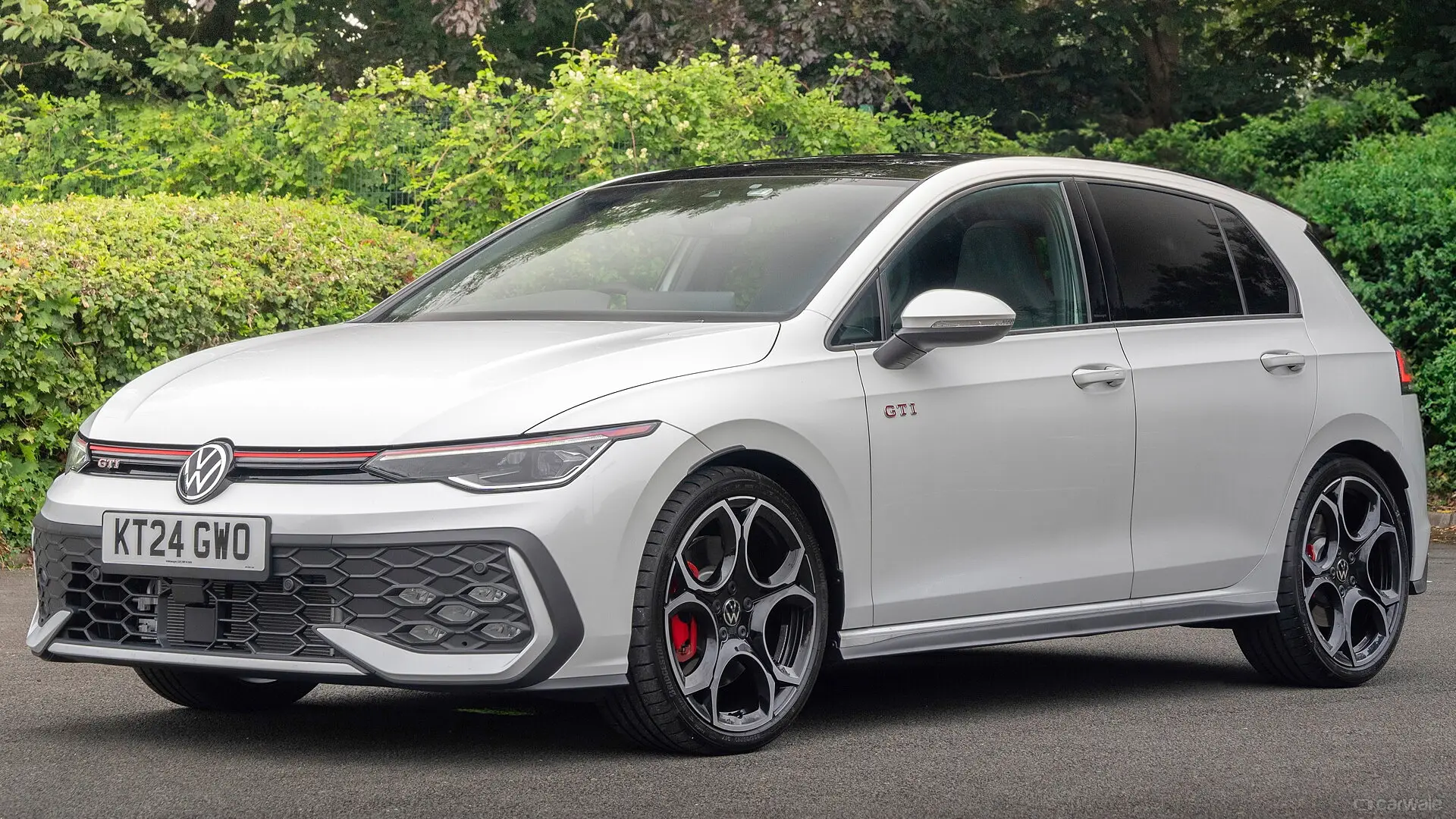
Material quality represents another area where the Golf distinguishes itself from both compact competitors and many midsize offerings. Rear passengers enjoy the same high-grade materials found in front seating positions either premium cloth or available leatherette with consistent texture and stitching throughout.
This democratic approach to material selection creates a cohesive cabin experience regardless of where passengers are seated. Attention to detail extends to the tactile elements that enhance rear seat comfort.
Well-positioned grab handles, damped reading lights, and precisely fitted door panels demonstrate Volkswagen’s commitment to craftsmanship throughout the cabin.
The rear doors themselves open wide to nearly 90 degrees, facilitating easy entry and exit a feature missing from many larger vehicles with surprisingly restrictive door openings.
Climate control effectiveness reaches all passengers thanks to rear floor vents that distribute warmed or cooled air throughout the cabin. This system design ensures rear occupants enjoy consistent temperature comfort rather than the neglect often experienced in compact cars with front-only ventilation systems.
Perhaps most remarkable is how the Golf accomplishes this passenger comfort while maintaining its signature tight turning radius and parking-friendly dimensions.
At just 168 inches long, the Golf fits in urban spaces that would challenge most midsize sedans, yet delivers comparable or superior rear passenger accommodations a compelling proposition for those who value interior space efficiency without exterior bulk.
3. Mazda3
The Mazda3 has evolved from a competent compact contender to a legitimate near-luxury offering, with its rear seating area exemplifying the brand’s upmarket transformation.
What makes the Mazda3’s back seat particularly impressive is how it combines dimensional adequacy with premium execution that creates a rear passenger experience superior to many midsize sedans commanding significantly higher prices.
Mazda’s approach to rear seat comfort begins with meticulous attention to human anatomy and natural posture. The company’s engineers have applied their “Jinba Ittai” (horse and rider as one) philosophy not just to driving dynamics but to passenger comfort as well.
The rear seat cushions are carefully sculpted to distribute weight properly across the occupant’s lower body, preventing pressure points that cause fatigue during longer journeys.
At 35.1 inches of legroom, the raw measurements appear merely competitive within the compact segment, but the thoughtful contours of the seats make this space feel more generous than the numbers suggest.
The upholstery quality in the Mazda3’s rear compartment deserves particular attention. Unlike many competitors that noticeably downgrade materials in back, Mazda maintains material consistency throughout the cabin.
Depending on trim level, rear passengers enjoy the same supple leatherette or genuine leather surfaces as those in front, with identical stitching patterns and padding density.
This democratic approach to material selection creates a cohesive premium environment regardless of seating position a stark contrast to midsize sedans that often betray their cost-cutting with visibly inferior rear upholstery.
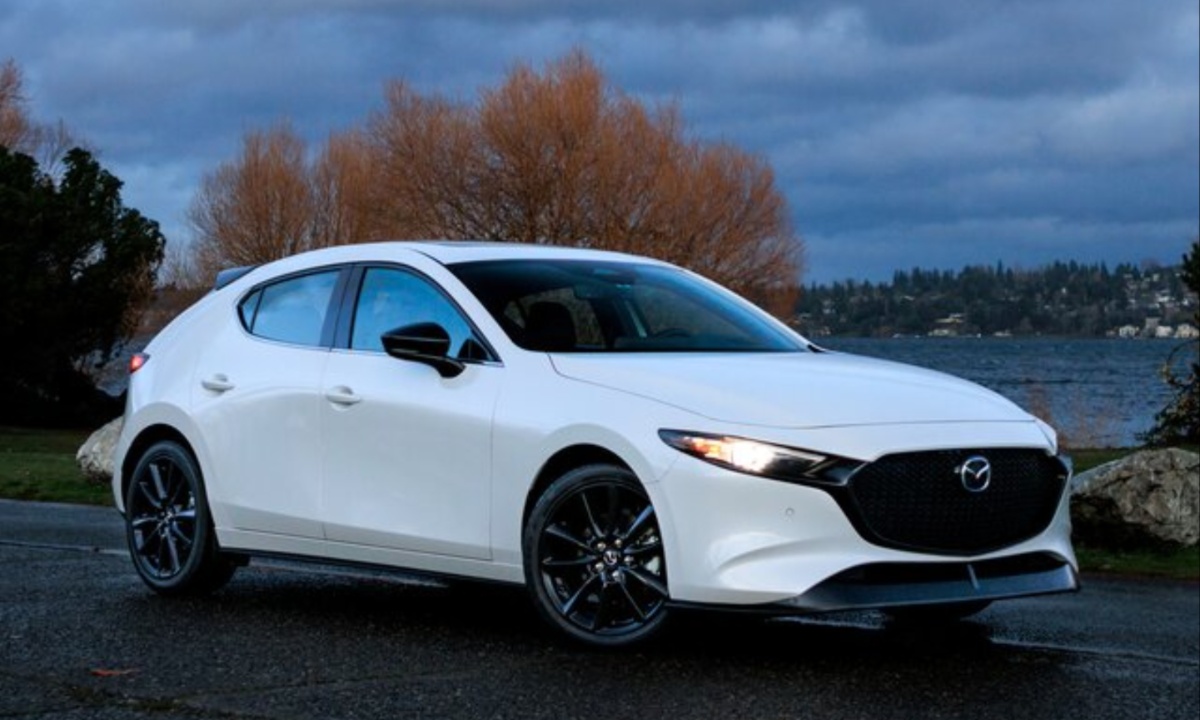
Sound management represents another area where the Mazda3 delivers a superior rear seat experience. The engineering team has applied extensive noise insulation throughout the vehicle, including the rear wheel wells and under the rear seat cushion areas often neglected even in larger vehicles.
This comprehensive approach to sound dampening creates a remarkably hushed environment for rear passengers, allowing conversation at normal speaking volumes even at highway speeds.
Many midsize sedans with their longer wheelbases and larger cabin volumes transmit more road and wind noise to rear occupants than this compact Mazda.
Thoughtful ergonomic touches enhance the rear passenger experience throughout. The door armrests are positioned at a natural height and feature sufficient padding for comfortable elbow support.
The center armrest (on higher trims) deploys at an ideal angle and includes properly sized cupholders positioned within easy reach. Even the seat belts deserve mention, with smooth-retracting mechanisms and buckles that don’t dig into passengers’ hips, small details that distinguish truly premium accommodations from merely spacious ones.
The Mazda3’s greenhouse design contributes significantly to rear passenger comfort through carefully considered sightlines. While many modern vehicles sacrifice window area for styling or structural rigidity, Mazda has maintained reasonably sized rear windows that prevent claustrophobia without compromising safety.
This balanced approach to visibility creates an airy feeling that many midsize sedans with their high beltlines and small rear windows simply cannot match.
Climate comfort extends to all passengers thanks to available rear air vents in higher trims, maintaining consistent temperature throughout the cabin.
Even in configurations without dedicated rear vents, the climate control system is calibrated to ensure effective air distribution to the back seats a level of environmental consideration not universally found in the midsize segment.
4. Toyota Corolla
The Toyota Corolla, long synonymous with reliable transportation, has evolved dramatically in its latest generation to address the historical criticism of its utilitarian rear seating area.
Today’s Corolla offers back seat accommodations that not only lead the compact segment but also challenge or exceed those found in many midsize sedans, including Toyota’s own Camry from just a few generations ago.
The foundation of the Corolla’s rear seat comfort begins with its adoption of the TNGA platform (Toyota New Global Architecture), which optimizes packaging efficiency to maximize interior volume despite modest exterior dimensions.
This architectural rethinking has yielded 34.8 inches of rear legroom, a figure that doesn’t tell the complete story of the available space. Toyota’s engineers have strategically sculpted the front seatbacks to create additional knee clearance, effectively adding usable space beyond what tape measurements suggest.
The rear floor is nearly flat, minimizing the center hump that typically forces the middle passenger to sit with knees raised in most compact and even midsize sedans.
Seat cushioning in the Corolla deserves particular praise for its exceptional balance between initial comfort and long-term support. Unlike many competitors that use overly soft foam that compresses uncomfortably during longer trips, Toyota has selected multi-density cushioning that maintains its supportive properties over hours of sitting.
The seat bottom provides proper thigh support with an ideal length that accommodates adults of varying heights, while the seatback features subtle lumbar contouring that promotes healthy posture attention to ergonomic detail typically reserved for front seats even in premium vehicles.
The Corolla’s climate control effectiveness extends fully to rear passengers through strategically positioned vents. On higher trim levels, dedicated rear HVAC outlets ensure consistent temperature throughout the cabin.
Even on base models without rear vents, Toyota has engineered the air distribution system to effectively reach back-seat occupants unlike many midsize competitors that neglect airflow to the rear compartment despite their larger interior volumes.
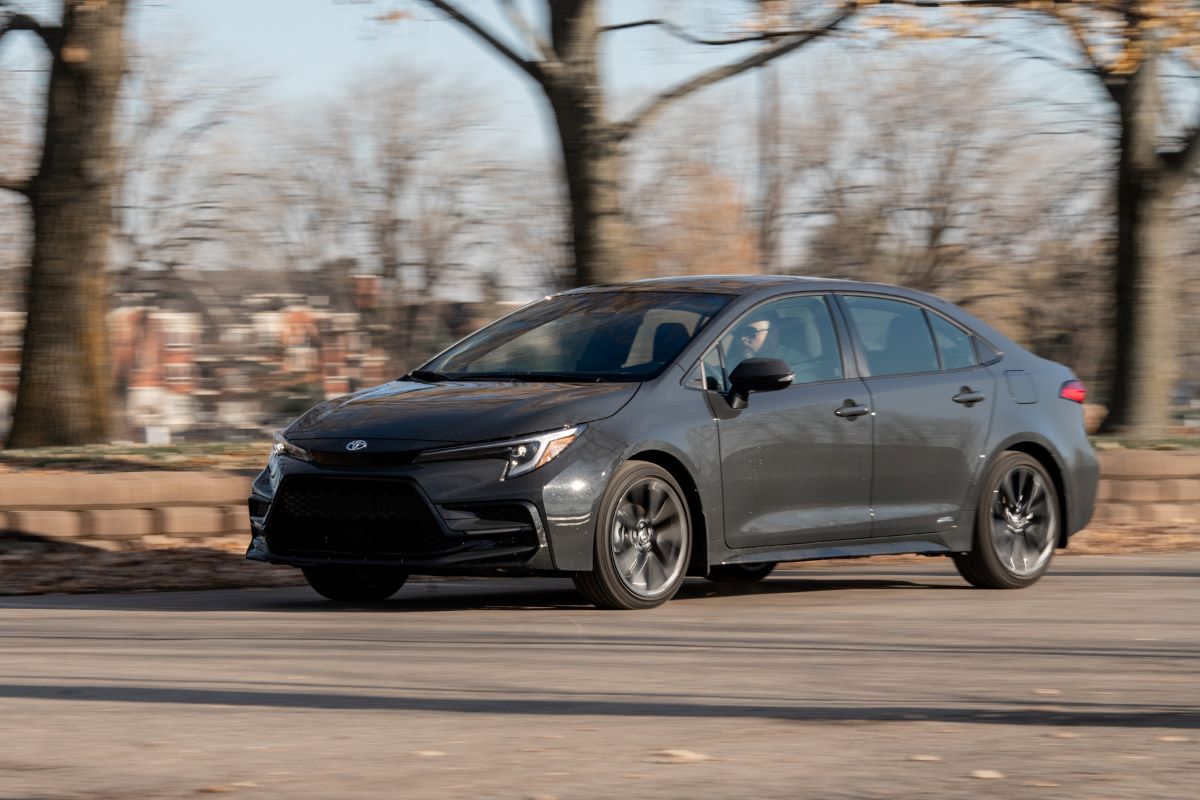
Material quality represents another area where the Corolla challenges larger sedans. The SofTex leatherette available on upper trims maintains consistent appearance and texture in both front and rear seating positions, without the obvious downgrade in material quality that plagues the rear accommodations of many midsize options.
Even the cloth upholstery on entry-level models features tight, even stitching and stain-resistant properties throughout the cabin. Door panel design enhances rear passenger comfort through properly positioned armrests with adequate padding a detail often overlooked even in more expensive vehicles.
The rear door openings are thoughtfully sized with hinges that allow doors to open wide, facilitating easy entry and exit even in tight parking situations.
This practical consideration stands in contrast to many midsize sedans with surprisingly restricted rear door apertures despite their larger overall dimensions.
Noise isolation represents a particularly impressive achievement in the Corolla’s rear compartment. Toyota has applied acoustic glass and strategic sound-deadening materials throughout the cabin, creating a remarkably hushed environment that rivals much more expensive vehicles.
This quiet operation enhances the perception of quality and allows easy conversation between front and rear passengers without raised voices a genuine luxury feature regardless of vehicle size.
Storage solutions around the rear seats are abundant and thoughtfully designed. Door pockets can accommodate water bottles plus additional items, seatback pockets feature divided sections for organizing materials, and the fold-down center armrest integrates properly sized cupholders positioned to prevent spills even during spirited driving.
Also Read: 10 Vehicles With Amazing Cargo Space Hidden Below the Floor
5. Hyundai Elantra
The Hyundai Elantra represents perhaps the most dramatic example of a compact car transcending traditional category limitations with its exceptional rear seat accommodations.
This Korean compact doesn’t merely compete with midsize sedans for back seat comfort in many measurable and subjective ways, it surpasses them, offering a rear passenger experience that challenges preconceptions about vehicle segments.
The most immediately apparent advantage of the Elantra’s rear seating area is its impressive dimensional specifications. With 38.0 inches of legroom, the Elantra doesn’t just approach midsize territory it exceeds the rear legroom measurements of many established midsize sedans including some premium offerings.
This generous space allocation results from Hyundai’s strategic wheelbase stretching to 107.1 inches, approaching dimensions typically associated with larger vehicle classes.
The floor is nearly flat, with minimal center tunnel intrusion that allows the middle passenger to sit naturally without the splayed-leg position required in many larger vehicles.
Beyond raw measurements, the Elantra elevates rear seat comfort through thoughtful ergonomic design. The seat cushions strike an ideal balance between plushness and support, with multi-density foam that prevents the “bottoming out” sensation common in compact car rear benches.
Research indicates that the seatback angle has been carefully calibrated to approximately 24 degrees, a recline that minimizes lower back fatigue during longer journeys.
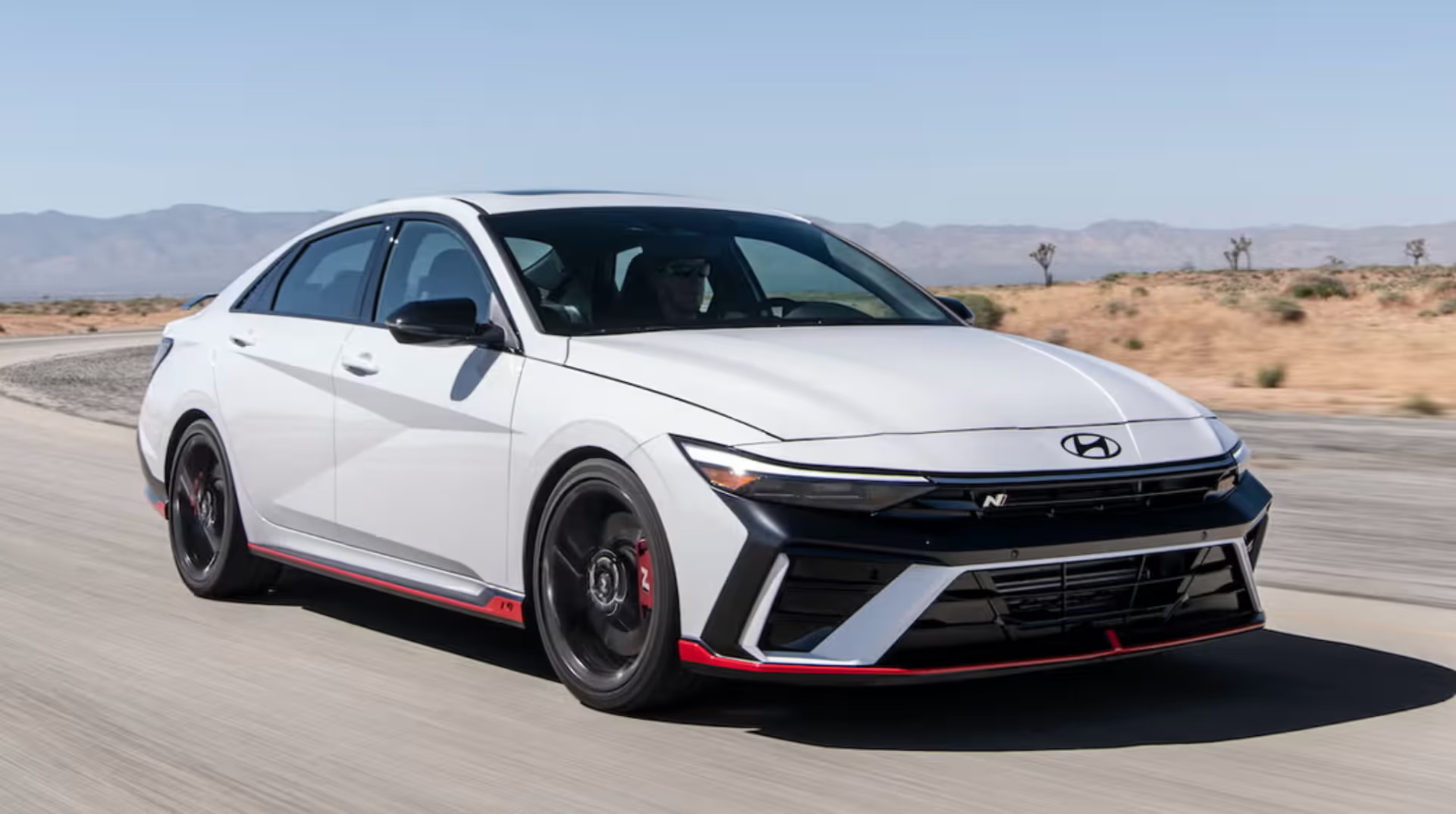
This attention to posture science results in a more comfortable seating position than many midsize sedans that feature more upright rear backrests despite their larger overall dimensions.
Material quality in the Elantra’s rear compartment deserves particular mention. Unlike many vehicles that noticeably downgrade upholstery and trim in the back, Hyundai maintains material consistency throughout the cabin.
On higher trim levels, the same premium leatherette or leather surfaces with identical stitching patterns extend to rear passengers, creating a cohesive luxury experience regardless of seating position.
Even on base models, the cloth upholstery maintains consistent texture and appearance front to back—a democratic approach to material selection that many midsize competitors fail to match.
Climate comfort for rear passengers receives proper attention through dedicated air vents on most trim levels. These outlets are positioned for optimal air distribution rather than merely checking a feature box, ensuring effective temperature management throughout the cabin.
The HVAC system is oversized relative to the Elantra’s interior volume, providing rapid cooling or heating that reaches all occupants equally performance that many larger vehicles with their more voluminous cabins struggle to achieve.
The Elantra distinguishes itself further through thoughtful convenience features for rear passengers. Multiple USB ports are strategically positioned for easy access, allowing device charging without awkward cable routing.
The door panels incorporate generously sized pockets that accommodate water bottles plus additional items, while seatback pockets feature dividers that prevent contents from shifting during transit.
On higher trims, heated rear seats a feature still considered premium even in the midsize segment, provide exceptional cold-weather comfort. Sound management represents another area where the Elantra delivers a superior experience.
Hyundai has applied extensive noise insulation throughout the vehicle, focusing particularly on isolating road and tire noise that typically infiltrates the rear compartment in compact cars.
The result is a remarkably hushed environment that allows normal-volume conversation between all occupants a genuine luxury experience that surpasses many ostensibly more premium midsize options.
6. Nissan Sentra
The Nissan Sentra’s transformation from basic transportation to compelling compact contender is perhaps most evident in its surprisingly accommodating rear seating area.
The latest generation represents Nissan’s focused effort to deliver midsize comfort within compact dimensions, creating a back seat experience that challenges conventional segment expectations and many larger sedans.
Central to the Sentra’s rear seat comfort is its exceptionally well-considered dimensional packaging. With 34.7 inches of legroom, the raw measurements are competitive within the compact segment, but Nissan’s engineers have maximized the usability of this space through clever design decisions.
The front seatbacks feature concave sculpting that creates additional knee clearance for rear passengers, effectively adding usable space beyond what tape measurements suggest.
This thoughtful approach to interior packaging means the Sentra’s rear accommodations feel more spacious than midsize sedans with similar or even slightly larger numerical specifications.
Seat cushioning quality represents a particular strength in the Sentra’s back seat design. Nissan has applied its “Zero Gravity” seating technology originally developed using NASA research, to the rear bench, incorporating multi-density foam that provides exceptional pressure distribution.
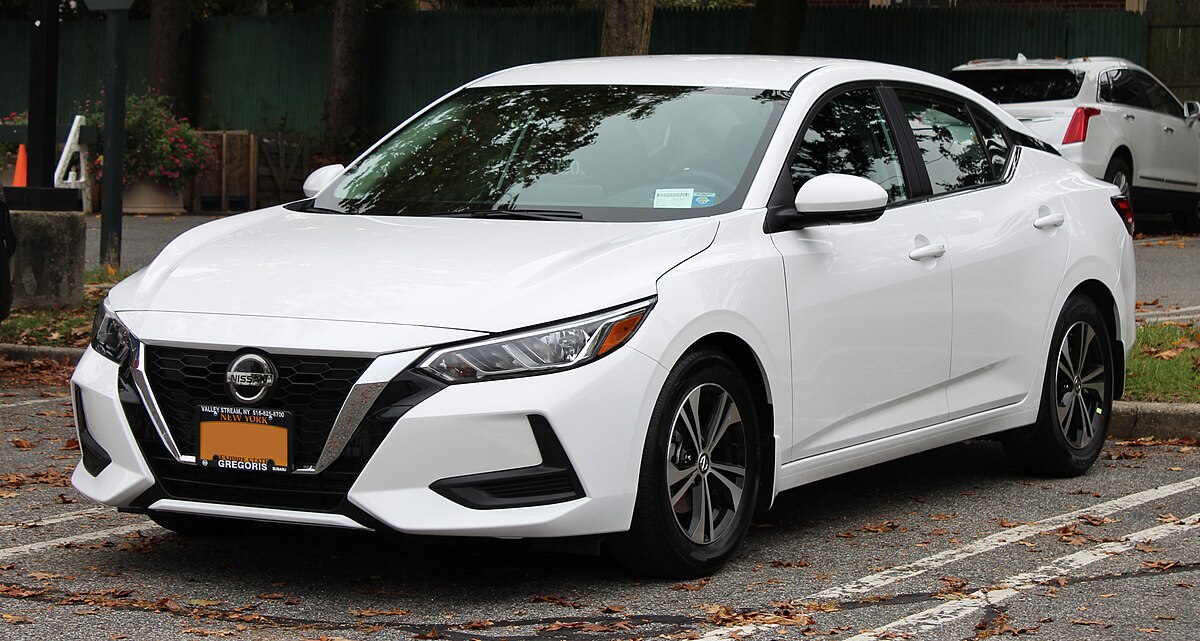
This sophisticated approach to cushioning prevents the discomfort hotspots common in competitors’ rear seats, allowing for longer journeys without fatigue.
The seat bottom length is properly calibrated to support adult thighs without creating pressure behind the knees, while the backrest contour supports the natural curvature of the spine, attention to ergonomic detail typically reserved for front seats even in premium vehicles.
The Sentra’s rear seat comfort is further enhanced by its exceptional headroom. Despite the vehicle’s sleek exterior profile, Nissan has maintained 36.7 inches of vertical clearance for rear passengers sufficient space for occupants well over six feet tall.
This dimension exceeds what many midsize sedans provide despite their larger overall footprints, as many competitors sacrifice rear headroom to achieve sloping rooflines for styling purposes. The Sentra’s balanced approach maintains both an attractive exterior design and functional interior space.
Material quality in the rear compartment demonstrates Nissan’s commitment to a consistent premium experience throughout the cabin. The Prima-Tex leatherette available on higher trims maintains identical appearance and texture in both front and rear positions, without the obvious downgrade in material quality that characterizes many midsize offerings.
Even the cloth upholstery on entry-level models features tight, even stitching with stain-resistant properties throughout the cabin. The rear door panels incorporate soft-touch materials at key contact points, enhancing the tactile experience for all passengers.
Climate comfort extends fully to rear occupants through rear air vents positioned for optimal flow distribution. The HVAC system itself is properly sized for the Sentra’s interior volume, providing rapid temperature adjustment throughout the cabin.
This effective climate management creates a consistent environment for all passengers performance that many larger sedans with their more voluminous interiors struggle to achieve.
The Sentra distinguishes itself further through exceptional noise management in the rear compartment. Nissan has applied acoustic insulation throughout the vehicle, with particular attention to isolating road and tire noise that typically intrudes more noticeably for rear passengers.
Additionally, the rear suspension design prioritizes ride smoothness and noise suppression with careful bushing tuning and vibration isolation. The result is a remarkably quiet environment that allows normal-volume conversation a comfort attribute where the Sentra outperforms many ostensibly more premium midsize options.
Entry and exit convenience often goes overlooked in rear seat evaluations but represents another area where the Sentra excels. The rear doors open to nearly 90 degrees with large apertures, facilitating easy access even in tight parking situations.
This practical consideration stands in contrast to many midsize sedans with surprisingly restricted rear door openings despite their larger overall dimensions.
7. Kia Forte
The Kia Forte has emerged as one of the compact segment’s hidden gems, particularly for rear seat passengers seeking comfort traditionally associated with larger vehicles.
What makes the Forte’s back seat accommodations truly impressive is how they combine thoughtful engineering with premium execution to create an experience that rivals or exceeds many midsize sedans costing thousands more.
The foundation of the Forte’s exceptional rear comfort begins with its dimensional efficiency. At 35.7 inches of legroom, the Forte offers numerical specifications that approach midsize territory, but the experience transcends what tape measurements suggest.
Kia’s engineers have sculpted the front seatbacks with recessed knee areas, effectively adding usable space without extending the wheelbase. The rear floor is nearly flat with minimal center tunnel intrusion, allowing the middle passenger to sit naturally without the splayed-leg position typically required in vehicles across multiple size categories.
Seat cushioning in the Forte deserves particular praise for its sophisticated approach to comfort. Unlike many competitors that use single-density foam that either feels initially plush but quickly compresses or remains firm but unyielding, Kia has employed multi-density cushioning that provides both immediate comfort and long-term support.
The seat bottom features proper length to support adult thighs without creating pressure points behind the knees, while the backrest incorporates subtle lumbar contouring that promotes healthy posture during extended journeys.
This attention to ergonomic science results in a seating experience superior to many midsize sedans that offer flatter, less anatomically considered rear benches despite their premium positioning.
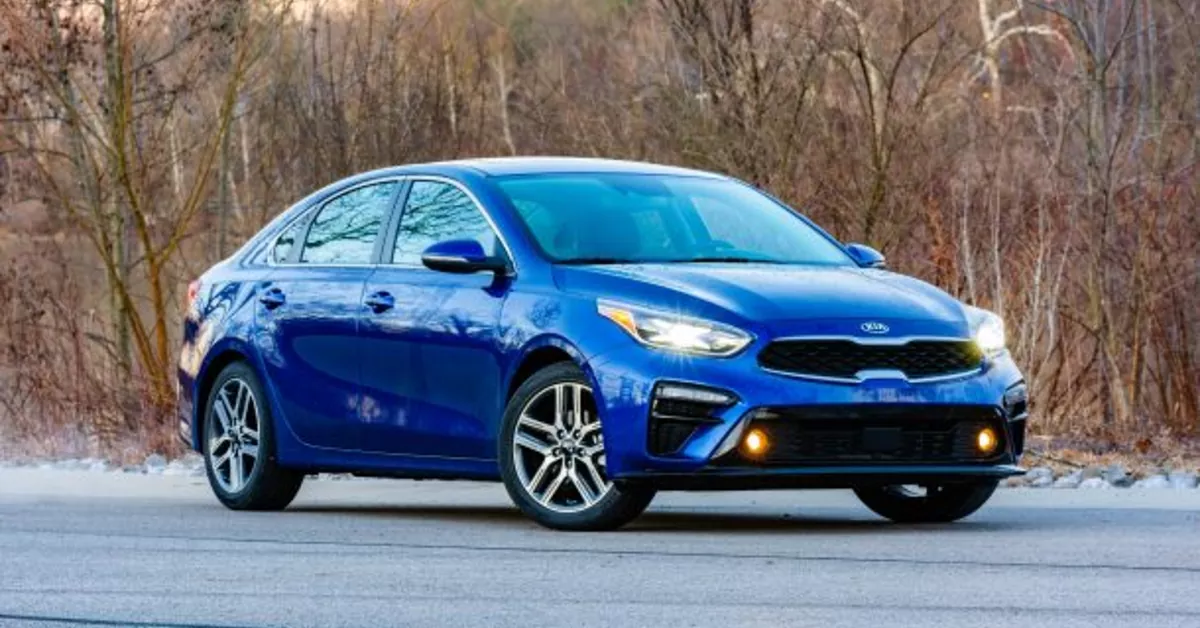
Material quality in the Forte’s rear compartment demonstrates Kia’s commitment to a consistent premium experience regardless of seating position.
The SynTex leatherette available on higher trims maintains identical appearance, stitching patterns, and pliability in both front and rear positions unlike many midsize competitors that noticeably downgrade materials for back seat passengers.
Even the cloth upholstery on entry-level models features tight, even weaving with stain-resistant properties throughout the cabin. The door panels incorporate soft-touch materials at key contact points, enhancing the tactile experience for all occupants.
Climate comfort extends fully to rear passengers through strategic engineering. While not all trim levels include dedicated rear air vents, Kia has sized the climate control system appropriately for the cabin volume and calibrated the air distribution to effectively reach back seat occupants.
On models equipped with rear vents, these outlets are positioned for optimal flow rather than merely checking a feature box. This thoughtful approach to temperature management creates a consistent environment throughout the cabin performance that many larger sedans with their more voluminous interiors struggle to achieve.
The Forte distinguishes itself further through exceptional noise management in the rear compartment. Kia has applied extensive sound deadening materials throughout the vehicle, with particular attention to isolating the rear seating area from road and tire noise.
The rear suspension geometry and bushing tuning prioritize comfort without compromising handling, effectively filtering out harsh impacts and vibrations before they reach occupants.
This comprehensive approach to noise and vibration management creates a remarkably hushed environment that allows conversation at normal volumes a genuine luxury experience that surpasses many ostensibly more premium midsize options.
Convenience features for rear passengers demonstrate Kia’s attention to detail throughout the cabin. The door armrests are positioned at a natural height with adequate padding for comfortable elbow support during longer journeys.
Storage solutions include properly sized door pockets that accommodate water bottles plus additional items, seatback pockets with sturdy construction, and a fold-down center armrest (on higher trims) that includes cupholders positioned to prevent spills even during spirited driving.
8. Subaru Impreza
The Subaru Impreza represents a unique approach to compact car design that yields exceptional rear seat comfort through thoughtful engineering priorities.
What distinguishes the Impreza’s back seat from many competitors including numerous midsize sedans is how it combines practical spaciousness with all-weather capability and straightforward functionality that perfectly aligns with Subaru’s adventure-ready brand identity.
The dimensional foundation of the Impreza’s rear seating area starts with an impressively space-efficient layout. With 36.5 inches of legroom, the raw measurements approach midsize territory, but Subaru’s packaging expertise maximizes the usability of this space.
The brand’s commitment to boxer engine architecture contributes significantly to rear passenger comfort, as the flat engine design allows for efficient front compartment packaging that doesn’t encroach on rear passenger space.
The standard all-wheel-drive system a rarity in the compact segment is integrated with minimal intrusion into the passenger cabin, maintaining a relatively flat rear floor that accommodates center passengers more comfortably than many larger vehicles with prominent driveline tunnels.
Seat design in the Impreza reflects Subaru’s practical approach to comfort. The cushioning strikes an ideal balance between initial softness and long-term support, with dense, durable foam that maintains its properties over time, unlike the quickly compressing cushions found in many competitors.
The seat bottom provides proper thigh support with an ideal length that accommodates adults of varying heights, while the backrest features a slightly reclined angle that promotes a natural seating posture.
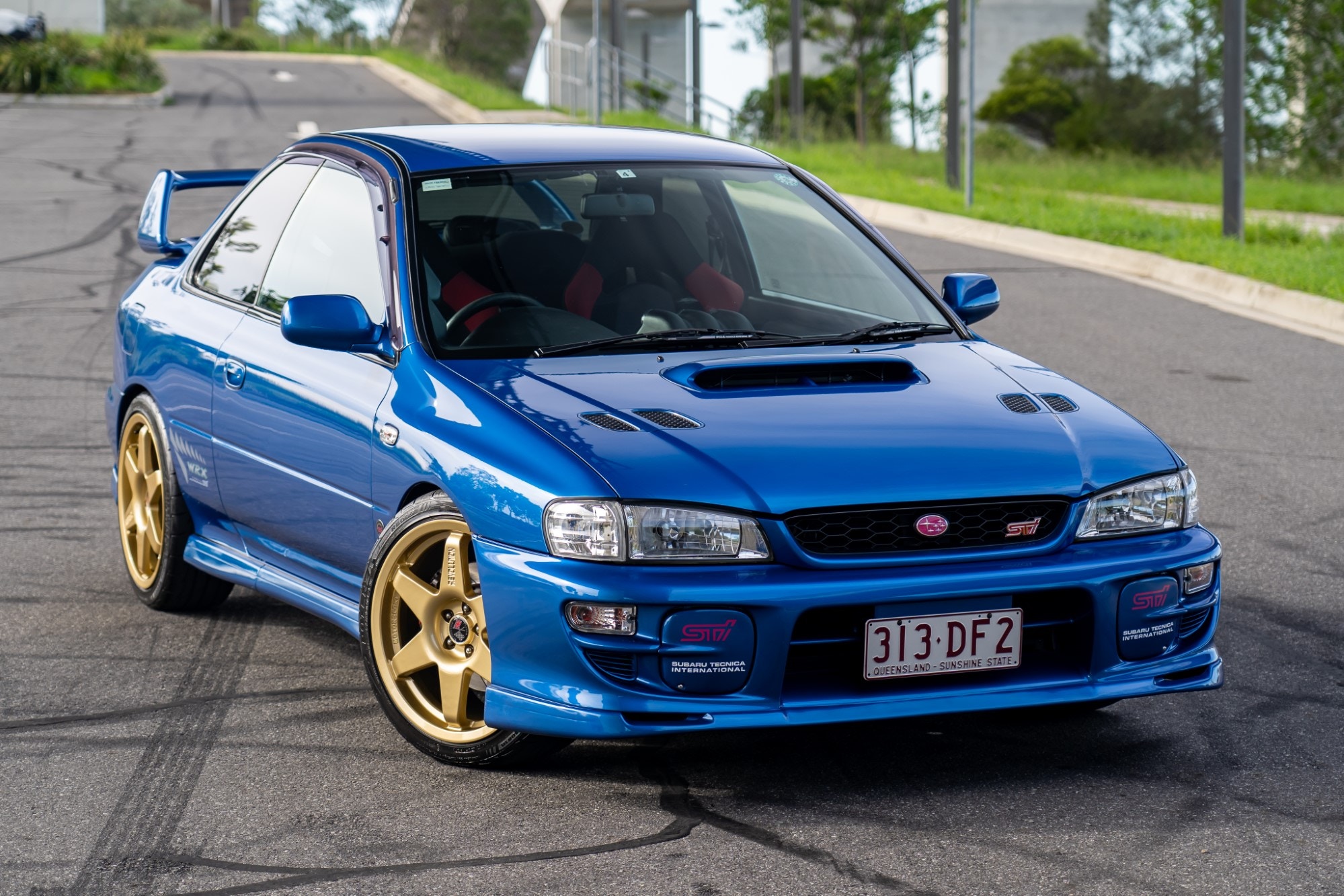
This straightforward approach to ergonomics without gimmicky contours results in genuine all-day comfort that many more complex (and expensive) seating designs in midsize sedans fail to deliver.
The Impreza particularly excels in headroom accommodation for rear passengers, with 37.2 inches of vertical clearance that exceeds many larger vehicles.
Subaru’s traditionally boxy greenhouse design prioritizes functional space over swooping rooflines, creating sufficient headroom for tall occupants without requiring them to slouch or tilt their heads.
This pragmatic approach to dimensional efficiency stands in stark contrast to many midsize sedans that sacrifice rear headroom to achieve fashionable exterior profiles.
Material selection throughout the Impreza’s cabin demonstrates Subaru’s emphasis on durability without compromising comfort. The cloth upholstery features tight, even weaving with stain-resistant properties designed to withstand the active lifestyle Subaru owners typically embrace.
Higher trim levels offer StarTex water-repellent material that combines premium appearance with practical durability. Unlike many vehicles that noticeably downgrade materials in the back, Subaru maintains consistent quality throughout the cabin, creating a democratic experience regardless of seating position.
Climate management in the Impreza reflects its all-weather capability ethos. The heating system delivers exceptional performance, warming the entire cabin quickly, even in extreme conditions, a comfort feature particularly appreciated by rear passengers in vehicles focused on cold-weather capability.
On higher trims, heated rear seats warm quickly and maintain a consistent temperature, providing comfort typically associated with luxury vehicles. The ventilation system effectively distributes air throughout the cabin, with available rear vents on premium trims ensuring all passengers enjoy consistent temperature regardless of external conditions.
The Impreza distinguishes itself further through its exceptional visibility for rear passengers. While many modern vehicles sacrifice window area for styling or structural considerations, Subaru maintains generous greenhouse dimensions with relatively low beltlines and large rear glass areas.
This approach creates an open, airy feeling for back seat occupants who enjoy expansive outward views, preventing the claustrophobic sensation common in many competitors despite their larger overall dimensions.
Noise management represents another area where the Impreza delivers a superior rear seat experience. Subaru has applied strategic sound insulation throughout the vehicle, focusing particularly on isolating road and tire noise that can become pronounced with all-weather tires and all-wheel-drive systems.
The result is a remarkably composed cabin environment that allows easy conversation between front and rear passengers a comfort attribute where many midsize sedans with their longer wheelbases underperform due to increased tire noise at the rear axle.
9. Chevrolet Bolt EV
The Chevrolet Bolt EV challenges conventional thinking about compact car accommodation through its innovative electric architecture. What makes the Bolt’s rear seating area particularly remarkable is how it leverages the inherent packaging advantages of electric propulsion to create back seat comfort that not only equals but in several ways exceeds what traditional midsize sedans offer despite their larger footprints.
The fundamental advantage of the Bolt’s rear seat spaciousness stems from its purpose-built electric vehicle platform. By eliminating the traditional engine, transmission, exhaust system, and fuel tank, Chevrolet’s engineers gained extraordinary freedom to prioritize passenger space within a compact exterior footprint.
The flat “skateboard” battery pack located beneath the floor creates a completely flat rear footwell without the central tunnel intrusion found in virtually all internal combustion vehicles.
This layout allows three adult passengers to sit naturally across the bench without compromise a rare capability even among much larger sedans.
Dimensional specifications tell part of the story, with the Bolt offering 36.5 inches of rear legroom a figure that matches or exceeds many midsize sedans. However, the subjective experience transcends what tape measurements suggest due to the Bolt’s tall roofline and upright seating position.
The generous 37.9 inches of rear headroom accommodates passengers well over six feet tall with space to spare vertical clearance that many larger vehicles sacrifice to achieve sleeker exterior profiles. This combination of legroom and headroom creates an airiness rarely found in any passenger car regardless of exterior dimensions.
Seat cushioning in the Bolt reflects Chevrolet’s thoughtful approach to electric vehicle comfort. The rear bench features properly dense foam that supports passengers without the excessive firmness sometimes employed to maximize battery range through weight reduction.
The seat bottom provides ideal thigh support with proper length to accommodate adults of varying heights, while the backrest angle strikes a balance between upright positioning for space efficiency and slight recline for comfort during longer journeys.
This attention to ergonomic detail results in genuine all-day comfort that many more complex (and expensive) seating designs in midsize sedans fail to deliver.
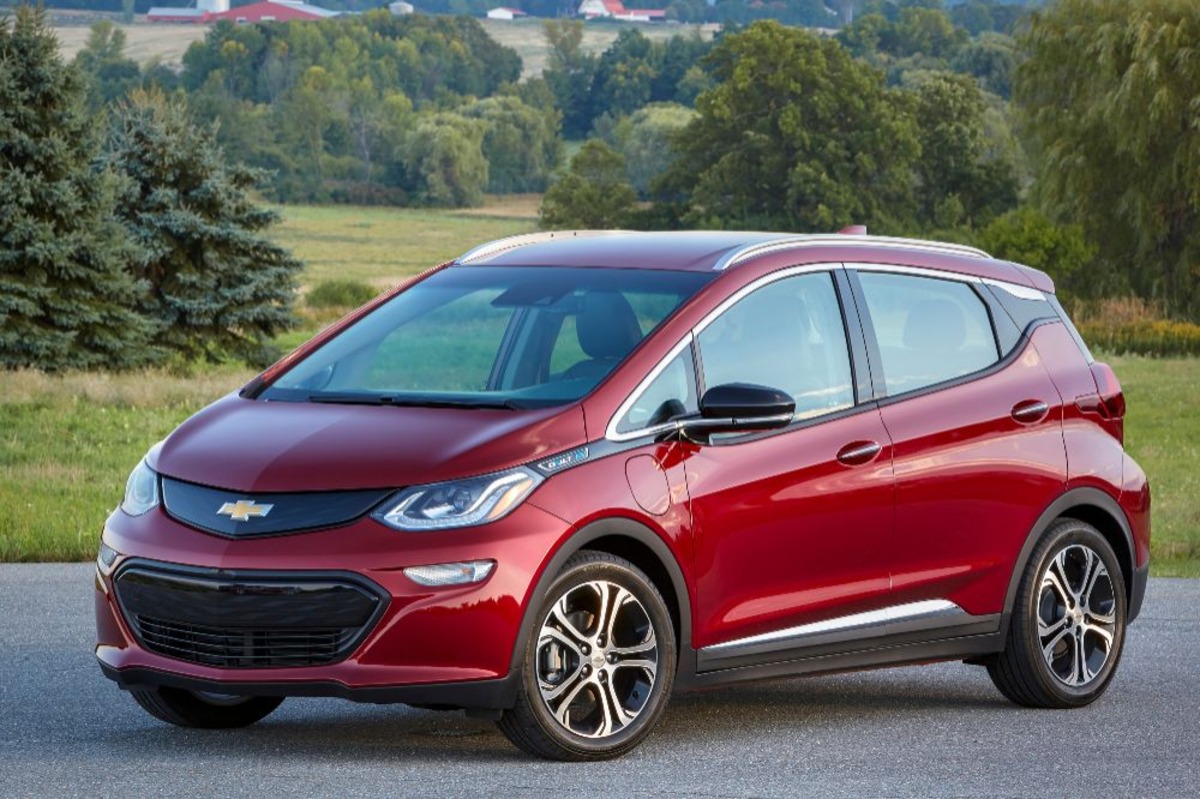
The Bolt’s climate control system deserves particular mention for its impact on rear passenger comfort. The electric HVAC system provides nearly instantaneous heating and cooling without waiting for an engine to reach operating temperature a significant advantage over internal combustion vehicles during extreme weather conditions.
The heat pump system employed in newer models operates with remarkable efficiency, maintaining a comfortable cabin temperature without significantly impacting driving range.
While not all trim levels include dedicated rear vents, the climate system is properly sized for the cabin volume and calibrated to effectively reach all occupants.
Material quality throughout the Bolt’s cabin demonstrates Chevrolet’s commitment to creating a premium electric vehicle experience. The durable cloth upholstery on base models features tight, even weaving with stain-resistant properties, while the available perforated leather maintains consistent appearance and texture in both front and rear positions.
The door panels incorporate soft-touch materials at key contact points, enhancing the tactile experience for all passengers. This consistent material application stands in contrast to many midsize sedans that noticeably downgrade interior finishes for rear occupants.
Storage solutions around the rear seats are abundant and thoughtfully designed. The door pockets easily accommodate water bottles plus additional items, seatback pockets feature divided sections for organizing materials, and strategic small-item storage areas are integrated throughout the rear compartment.
This practical approach to interior organization often exceeds what midsize sedans provide despite their larger interior volumes. Perhaps most remarkable is how the Bolt delivers this exceptional rear seat comfort while maintaining exterior dimensions that facilitate urban maneuverability and easy parking.
At just 163.9 inches long nearly two feet shorter than typical midsize sedans, the Bolt fits confidently into compact parking spaces and navigates crowded city streets with ease.
This combination of interior spaciousness and exterior compactness demonstrates the fundamental advantage of purpose-built electric architecture for passenger comfort without exterior bulk.
10. MINI Countryman
The MINI Countryman defies easy categorization, straddling the line between compact crossover and hatchback while delivering a surprisingly spacious and premium rear seating experience.
What makes the Countryman’s back seat particularly impressive is how it combines the brand’s iconic design language and driving character with practical accommodation that rivals or exceeds many midsize sedans despite the MINI’s distinctive compact proportions.
The Countryman’s rear seat spaciousness begins with clever dimensional engineering that maximizes interior volume within its footprint. At 37.6 inches of rear legroom, the raw measurements surpass many midsize sedans, but the experience transcends what tape measurements suggest.
The tall roof height creates exceptional headroom that accommodates passengers well over six feet tall without compromise vertical clearance that many larger vehicles sacrifice to achieve sleeker exterior profiles.
This combination of legroom and headroom creates a genuinely spacious feeling that belies the vehicle’s exterior dimensions. Seat design in the Countryman reflects MINI’s premium positioning within the BMW Group.
The rear bench features sophisticated multi-density foam cushioning that provides both immediate comfort and long-term support during extended journeys.
The seat bottom offers proper thigh support with ideal length to accommodate adults of varying heights, while the backrest incorporates subtle lumbar contouring that promotes healthy posture.
The outboard seating positions feature noticeable bolstering that provides lateral support during spirited driving, a sporting touch that acknowledges the brand’s driver-focused heritage without compromising passenger comfort.
Material quality throughout the Countryman’s cabin demonstrates MINI’s commitment to premium execution regardless of seating position. The available leather upholstery maintains consistent grain pattern, stitching quality, and pliability in both front and rear positions, unlike many midsize competitors that noticeably downgrade materials for back seat passengers.
Even the base cloth upholstery features tight, even weaving with a distinctive pattern that extends the vehicle’s design aesthetic throughout the cabin. The door panels incorporate soft-touch materials with contrast stitching at key contact points, enhancing the tactile experience for all occupants.

The Countryman distinguishes itself through thoughtful convenience features for rear passengers. The sliding and reclining rear seats—a rarity in the compact segment—allow occupants to prioritize either legroom or cargo space as needed.
This adjustability creates a flexibility that many larger vehicles with fixed rear benches cannot match. The door openings are generously sized with hinges that allow doors to open wide, facilitating easy entry and exit even in tight parking situations.
This practical consideration stands in contrast to many midsize sedans with surprisingly restricted rear door apertures despite their larger overall dimensions. Climate comfort extends fully to rear passengers through standard rear air vents positioned for optimal flow distribution.
The climate control system is properly sized for the cabin volume, providing rapid temperature adjustment throughout the interior. On higher trims, heated rear seats warm quickly and maintain consistent temperature across the entire seating surface a premium feature not universally offered even among midsize luxury sedans.
Storage solutions around the rear seats are abundant and thoughtfully designed. The door pockets easily accommodate water bottles plus additional items, seatback pockets feature sturdy construction with distinctive design elements that extend the cabin’s aesthetic, and a fold-down center armrest includes properly sized cupholders positioned to prevent spills even during enthusiastic driving.
Strategic small-item storage areas are integrated throughout the rear compartment, reflecting MINI’s traditional emphasis on clever space utilization. Perhaps most impressive is how the Countryman delivers this exceptional rear seat comfort while maintaining the brand’s characteristic driving dynamics.
At just 169.7 inches long, significantly shorter than typical midsize sedans, the Countryman fits confidently into urban spaces while delivering interior accommodation that rivals much larger vehicles. This combination of exterior compactness with interior spaciousness exemplifies thoughtful design that prioritizes efficiency without compromise.
Visibility for rear passengers represents another area where the Countryman outperforms many larger vehicles. The large greenhouse with relatively upright windows creates expansive outward views that prevent the claustrophobic feeling common in many modern vehicles with high beltlines and small windows.
This open, airy feeling enhances the perception of spaciousness beyond what dimensional measurements suggest. Sound management in the Countryman reflects its premium positioning.
MINI has applied extensive acoustic insulation throughout the vehicle, focusing particularly on isolating road and tire noise that typically intrudes more noticeably for rear passengers.
Also Read: 10 Vehicles With Amazing Cargo Space Hidden Below the Floor

